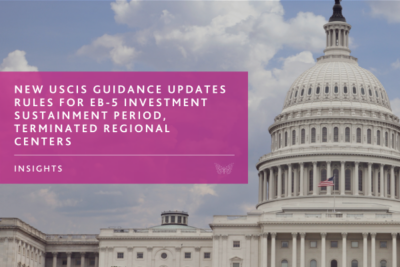On June 24, 2025, IIUSA hosted a webinar to unveil its first economic impact study in nearly five years—and the numbers made one thing clear: the EB-5 program remains a powerful engine of economic growth in the United States.

CanAm Enterprises was honored to take part in this important conversation, with our Chief Operating Officer, Christine Chen, joining a panel of industry experts to unpack the study’s findings and discuss what they mean for the future of EB-5. The panel included:
- Lee Y. Li, Director of Policy Research & Data Analytics, IIUSA
- Jerry Paytas, Lead Economist, Fourth Economy
- Christine Chen, COO, CanAm Enterprises
- Ed Smith, Managing Director, JTC
Together, the panelists provided timely analysis on how EB-5 capital fuels American job creation, infrastructure development, and private investment—all at no cost to U.S. taxpayers.
EB-5’s Impact by the Numbers (2016–2019)
The IIUSA-commissioned study, conducted by independent research firm Fourth Economy, analyzed EB-5 activity between 2016 and 2019. Here’s what the data shows:
- $75.2 billion in total project investment
- 1.7 million U.S. jobs created
- $122 billion in wages paid to American workers
- $14.5 billion in tax revenue generated
- $184 billion in GDP contribution
Each EB-5 investor created 45 American jobs, and every $500,000 invested through EB-5 generated an additional $1.6 million in private investment—yielding a 3.3x ROI. These results reflect EB-5’s unmatched ability to attract foreign direct investment while delivering meaningful benefits to the American economy.
Widespread National and Sectoral Benefits
The study revealed that EB-5 capital had broad, nationwide impact, reaching communities in all 50 states. The top five states by EB-5 investment included:
- California – $18.1B in total project investment
- New York – $15.3B
- Texas – $5.6B
- Florida – $5.0B
- Nevada – $3.4B
Major industry sectors benefiting from EB-5 investment included construction, hospitality, transportation, retail, and healthcare.
What Could EB-5 Achieve Without Constraints?
The panel also explored what the EB-5 program could deliver if current structural barriers were lifted—such as visa caps, processing delays, and the lack of permanent reauthorization.
According to the study, a fully optimized EB-5 program could generate annually:
- 3.1 million jobs
- $32 billion in foreign investment
- $27 billion in annual tax revenue
Christine Chen highlighted the importance of removing these bottlenecks to fully realize EB-5’s potential. “The data speaks for itself,” she said. “EB-5 is not just a job creation tool—it’s a strategic economic driver. We owe it to American communities and international investors alike to modernize and stabilize the program.”
A Call to Action: What Comes Next
The webinar concluded with a clear call to action:
- Support permanent reauthorization of the Regional Center Program to provide long-term certainty.
- Reform visa allocations by not counting derivative family members toward the annual cap.
- Improve processing efficiency to reduce backlogs and delays.
- Share the findings to help educate stakeholders, policymakers, and the public on EB-5’s proven value.
You can read the full IIUSA Economic Impact Report here. A full recording of the webinar will be available soon on IIUSA’s website.
At CanAm, We’re Proud to Help EB-5 Deliver on Its Promise
With more than $2.5 billion in EB-5 capital repaid, representing more than 5,000 investor families, CanAm has long championed the EB-5 program’s potential. We are proud to participate in efforts like this study and webinar that advance the industry’s understanding and visibility.
As Christine emphasized during the panel: “We need to ensure this program continues to serve its original mission—delivering jobs, growth, and opportunity across America.”
Dive Deeper Into EB-5:




